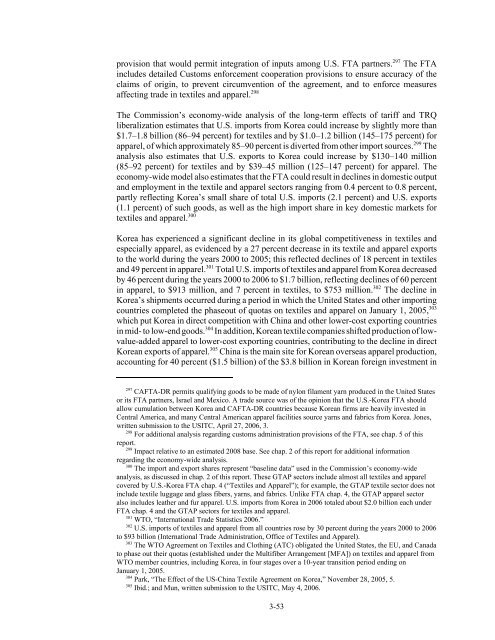U.S.-Korea Free Trade Agreement: Potential Economy-wide ... - USITC
U.S.-Korea Free Trade Agreement: Potential Economy-wide ... - USITC
U.S.-Korea Free Trade Agreement: Potential Economy-wide ... - USITC
Create successful ePaper yourself
Turn your PDF publications into a flip-book with our unique Google optimized e-Paper software.
provision that would permit integration of inputs among U.S. FTA partners. 297 The FTA<br />
includes detailed Customs enforcement cooperation provisions to ensure accuracy of the<br />
claims of origin, to prevent circumvention of the agreement, and to enforce measures<br />
affecting trade in textiles and apparel. 298<br />
The Commission’s economy-<strong>wide</strong> analysis of the long-term effects of tariff and TRQ<br />
liberalization estimates that U.S. imports from <strong>Korea</strong> could increase by slightly more than<br />
$1.7–1.8 billion (86–94 percent) for textiles and by $1.0–1.2 billion (145–175 percent) for<br />
apparel, of which approximately 85–90 percent is diverted from other import sources. 299 The<br />
analysis also estimates that U.S. exports to <strong>Korea</strong> could increase by $130–140 million<br />
(85–92 percent) for textiles and by $39–45 million (125–147 percent) for apparel. The<br />
economy-<strong>wide</strong> model also estimates that the FTA could result in declines in domestic output<br />
and employment in the textile and apparel sectors ranging from 0.4 percent to 0.8 percent,<br />
partly reflecting <strong>Korea</strong>’s small share of total U.S. imports (2.1 percent) and U.S. exports<br />
(1.1 percent) of such goods, as well as the high import share in key domestic markets for<br />
textiles and apparel. 300<br />
<strong>Korea</strong> has experienced a significant decline in its global competitiveness in textiles and<br />
especially apparel, as evidenced by a 27 percent decrease in its textile and apparel exports<br />
to the world during the years 2000 to 2005; this reflected declines of 18 percent in textiles<br />
and 49 percent in apparel. 301 Total U.S. imports of textiles and apparel from <strong>Korea</strong> decreased<br />
by 46 percent during the years 2000 to 2006 to $1.7 billion, reflecting declines of 60 percent<br />
in apparel, to $913 million, and 7 percent in textiles, to $753 million. 302 The decline in<br />
<strong>Korea</strong>’s shipments occurred during a period in which the United States and other importing<br />
countries completed the phaseout of quotas on textiles and apparel on January 1, 2005, 303<br />
which put <strong>Korea</strong> in direct competition with China and other lower-cost exporting countries<br />
in mid- to low-end goods. 304 In addition, <strong>Korea</strong>n textile companies shifted production of lowvalue-added<br />
apparel to lower-cost exporting countries, contributing to the decline in direct<br />
<strong>Korea</strong>n exports of apparel. 305 China is the main site for <strong>Korea</strong>n overseas apparel production,<br />
accounting for 40 percent ($1.5 billion) of the $3.8 billion in <strong>Korea</strong>n foreign investment in<br />
297 CAFTA-DR permits qualifying goods to be made of nylon filament yarn produced in the United States<br />
or its FTA partners, Israel and Mexico. A trade source was of the opinion that the U.S.-<strong>Korea</strong> FTA should<br />
allow cumulation between <strong>Korea</strong> and CAFTA-DR countries because <strong>Korea</strong>n firms are heavily invested in<br />
Central America, and many Central American apparel facilities source yarns and fabrics from <strong>Korea</strong>. Jones,<br />
written submission to the <strong>USITC</strong>, April 27, 2006, 3.<br />
298 For additional analysis regarding customs administration provisions of the FTA, see chap. 5 of this<br />
report.<br />
299 Impact relative to an estimated 2008 base. See chap. 2 of this report for additional information<br />
regarding the economy-<strong>wide</strong> analysis.<br />
300 The import and export shares represent “baseline data” used in the Commission’s economy-<strong>wide</strong><br />
analysis, as discussed in chap. 2 of this report. These GTAP sectors include almost all textiles and apparel<br />
covered by U.S.-<strong>Korea</strong> FTA chap. 4 (“Textiles and Apparel”); for example, the GTAP textile sector does not<br />
include textile luggage and glass fibers, yarns, and fabrics. Unlike FTA chap. 4, the GTAP apparel sector<br />
also includes leather and fur apparel. U.S. imports from <strong>Korea</strong> in 2006 totaled about $2.0 billion each under<br />
FTA chap. 4 and the GTAP sectors for textiles and apparel.<br />
301 WTO, “International <strong>Trade</strong> Statistics 2006.”<br />
302 U.S. imports of textiles and apparel from all countries rose by 30 percent during the years 2000 to 2006<br />
to $93 billion (International <strong>Trade</strong> Administration, Office of Textiles and Apparel).<br />
303 The WTO <strong>Agreement</strong> on Textiles and Clothing (ATC) obligated the United States, the EU, and Canada<br />
to phase out their quotas (established under the Multifiber Arrangement [MFA]) on textiles and apparel from<br />
WTO member countries, including <strong>Korea</strong>, in four stages over a 10-year transition period ending on<br />
January 1, 2005.<br />
304 Park, “The Effect of the US-China Textile <strong>Agreement</strong> on <strong>Korea</strong>,” November 28, 2005, 5.<br />
305 Ibid.; and Mun, written submission to the <strong>USITC</strong>, May 4, 2006.<br />
3-53

















